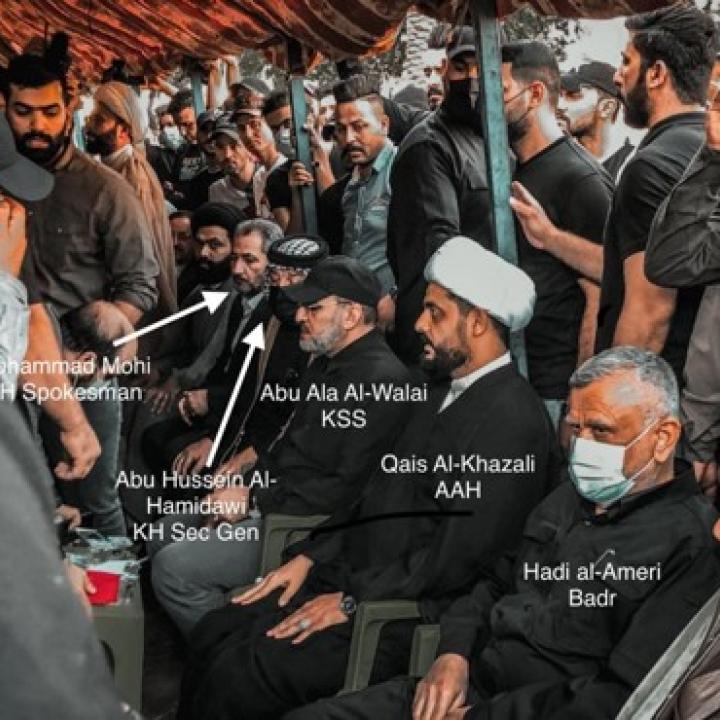
Muqawama Meltdown, Part 1: Protesting the Election

In the wake of their failed election campaigns and other recent setbacks, militias sought to deepen their claims of victimhood and politically damage Prime Minister Kadhimi with protests.
Iraqi muqawama (resistance) groups have been increasingly isolated over the past two weeks. First, Asaib Ahl al-Haq (AAH) and Kataib Hezbollah (KH) suffered dismal electoral failures via the Hoquq list. Then Muqtada al-Sadr began to peel away some of their supporters such as the Badr Organization and Nouri al-Maliki. At the same time, some KH operators were successfully prosecuted for killing protestors in Basra, while various muqawama officials were purged from intelligence agencies. This isolation seemingly prompted a coordinated but hasty response by KH and AAH. Part 1 of this article looks at their protest activities; Part 2 examines the November 7 drone attack on Prime Minister Mustafa al-Kadhimi's residence.
November 4: Rhetorical Escalation
AAH and KH ramped up pre-protest rhetoric on November 4. In an interview with al-Ahd TV, AAH leader Qais al-Khazali stated that “the participants of the sit-in cannot return to their homes as losers." He added that AAH might boycott the newly elected parliament. Other AAH members went further: Abdulamir al-Teiban, a parliamentarian from al-Sadiqoun (AAH’s political wing), tweeted on November 4, “My advice to the Iraqi leaders who were removed from the arena of political decisionmaking by the U.S. embassy and the UAE by means of elections...If you...turn a blind eye to this farce in exchange for fleeting benefits, your fate will be like the end of [slain Libyan leader] Muammar Qadhafi, whose head was torn off by uncontrolled gangs [operating] under French supervision.”
November 5: Initiating Protests
On November 5, muqawama supporters advanced on the International Zone, throwing stones at security forces, who unleashed tear gas and fired live rounds into the air. According to Reuters, hospital sources indicated that more than twenty-one protestors were hurt, mostly from smoke inhalation, while nine police officers were injured by stones. At least one recorded fatality occurred. The muqawama made a huge deal of the clash, which was fairly small by Iraqi protest standards, underlining their typical focus on shaping the perception of reality more than reality itself.
Militia Spotlight observed intense, pre-planned media activity across the muqawama channels, especially KH and AAH outlets, which shared videos and photographs of the protest and images of wounded protestors. Throughout, Badr-affiliated platforms such as Munasat Baa remained largely silent about the International Zone incident, suggesting a lack of interest or support from the Badr side of the Fatah political bloc.
From approximately 17:16 hours Baghdad time, a statement by the newly formed “Preparatory Committee for the Demonstrations Rejecting the Election Results in Baghdad and the Governorates” (al-lajnat al-tahdiriya lil-tazhahirat al-rafida li-nataij al-intikhabat fi Baghdad wal-muhafizhat) was republished by Sabereen News, followed by various AAH and KH Telegram channels. The statement reiterated the claims of election fraud and called for holding Prime Minister Kadhimi and military commanders Abdul-Wahab al-Saadi and Hamid al-Zuhairi “directly responsible for the killing and wounding of dozens of martyrs” (intelligence official Abu Ragheef and Deputy Chief of Staff Abdul Amir al-Shammari were also targeted with threats). Militia information operations sought to create a wave of support for initiating criminal indictments against such figures and effectively ending Kadhimi's bid for reappointment. The next day, this messaging had been mass-produced on signs for protestors to carry.
By 23:00 hours, Khazali arrived at the protest site and declared, "We will hold the aggressors against peaceful protestors legally accountable.” He also directly threatened Kadhimi: "My message to Kadhimi himself is this: the blood of these martyrs from your response with live ammunition...your response in this manner shows that you are the main figure behind the [election] fraud...To Kadhimi and whoever stands with Kadhimi and anyone who participated in this crime…, [revenge] for the blood of the martyrs [will be achieved] by trying you. We never abandoned [our revenge for] the blood of Abu Mahdi [al-Muhandis] and Hajj Qasem [Soleimani]...Our response reached each and every American base…You Kadhimi, hear it from [me], [revenge for] the blood of the martyrs is our responsibility, which will be achieved by trying you...and anyone who took part in firing [at the protestors].” The next day, KH Telegram outlet Unit 10,000 released a list of security force personnel allegedly responsible for killings, stating, “This time we only publish your names, next time it will be your address, picture, and even weapon serial number.”
November 6: Sit-In and Funeral
Another muqawama protest was held in Baghdad on November 6, this time as a sit-in to “offer condolences for the martyrs of the crimes of the government.” The sit-in was attended by a who’s who of militia leaders, including Khazali, Abu Hussein al-Hamidawi (KH’s secretary-general, who was able to attend with the assistance of a walking stick), Muhammad Mohi (KH spokesman), Hossein Moanes (KH’s Hoquq list leader, aka Abu Ali al-Askari), Abu Ala al-Walai (secretary-general of Kataib Sayyid al-Shuhada), and Hadi al-Ameri (Badr Organization). Also in attendance were KH’s Abu Fadak (the operational head of Iraq's Popular Mobilization Forces) and Kataib Imam al-Ali leader Shibl al-Zaydi. The muqawama sought to generate further sympathy on November 7, with most of the above leaders attending a funeral and wake for the dead rioter.
The November 4-7 sequence show KH and AAH working together in a rapid and integrated manner, blending their propaganda networks, to signal that they will not be isolated and that they have similar interests in this effort. Part of this message was no doubt aimed at muqawama politicians who may be exploring paths of accommodation with Muqtada al-Sadr, such as Ameri and Maliki. Such leaders were literally forced back into the muqawama's tent (see Figure 2).
In Part 2 of this article, Militia Spotlight looks at the abrupt (and seemingly counterproductive) drone attacks launched on Kadhimi's residence on November 7.








